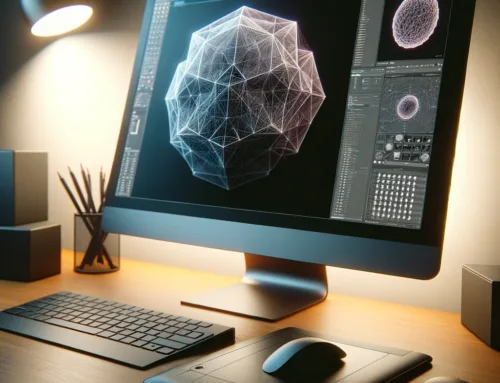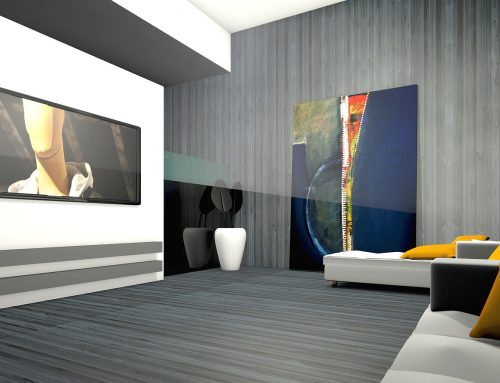Wie Sie zwischen den Blender Renderer und Cycles eine Auswahl treffen können.
Wenn Sie jemals ein neues, offizielles Build von Blender geöffnet haben, kennen Sie vielleicht den Button in der oberen Mitte des Fensters, auf dem „Blender Render“ steht. Wahrscheinlich kennen Sie diesen Button nur, weil es der Button ist, mit dem Sie zum „Cycles“-Renderer wechseln. Aber warum schalten wir es auf Cycles um? Was hat es sich mit dem Blender Renderer auf sich?

Blender Renderer.
Auch bekannt als „Blender Internal“ (oder BI), ist dies Blender`s ursprüngliche Render-Engine mit Quellcode aus den frühen 90er Jahren. Es ist ein Sammelsurium aus neuer (ish) und alter Rendertechnologie, die zusammengefercht sind, einschließlich Raytracing, Subsurface Scattering, glänzende Reflexionen und sogar eine primitive globale Beleuchtungsfunktion, im Allgemeinen ist es eine sehr schnelle Render-Engine für die meisten seiner Funktionen und zeichnet sich durch nicht-fotorealistisches (NPR) Rendering aus. Aber es leidet erheblich unter dem Fotorealismus. BI wurde in einer Zeit enwickelt, in der Realismus nur durch Illusionen erreicht werden konnte. Mit Tricks und Hacks, um die Eigenschaften der Realität zu fälschen, aber Sie haben wahrscheinlich in den letzten Jahren nicht viel über BI gehört geschweige denn den Renderer genutzt. Warum ist BI so wenig bekannt?
Cycles.
Ab 2011 bietet Blender zusätzlich einen neuartigen, innovativen Renderer mit der Bezeichnung Cycles in seinem Toolset an. Es ist ein gewaltiger Schritt nach vorne in Bezug auf realistisches Rendering, mit vollwertigem „Global Illumination“ und physikalisch genauen Berechnungen: Sie fragen sich jetzt: „Warum ist es eine separate Engine und kein Upgrade auf BI?“ Manchmal ist es einfach leichter von 0 anzufangen, als eine bestehende Sache zu ändern. BI hat eine jahrelange Entwicklung mit vielen Funktionen und Upgrades hinter sich. Im Laufe der Zeit wurde es immer schwieriger, die Entwicklung fortzusetzen und so entschied sich Brecht, eine neue Engine von Grund auf zu entwickeln, welche sich großer Beliebtheit erfreute und schnell zur ersten Render-Engine von Blender avancierte. Cycles hat sich in der Computergrafikindustrie einen beachtlichen Ruf erworben. Tatsächlich haben andere 3D-Softwareentwickler es sogar auf andere Anwendungen wie Cinema 4D und Rhino portiert.
Warum also keine der beiden Engines kategorisch abschließen?
Diese Frage lässt sich mit einer anderen Frage beantworten: Seit wann sind Alternativen etwas Schlechtes? Die Realität ist, dass BI und Cycles die Dinge so unterschiedlich machen, dass sie nicht wirklich konkurrieren. Vielmehr sind sie zwei Werkzeuge, die ihre jeweiligen Vorzüge haben.
Wann der Blender Renderer eine gute Wahl ist:
- Schnelle Renderings: Wenn Sie jemals schnell ein Basic-Rendering benötigen, sollte BI ihre erste Option sein. Mit „Basic Rendering“ meinen wir einfach nur Lighting und Materialien. Als Scanline-Renderer ist das Sample-Rauschen meist kein Thema. Bei Cycles wird die Engine immer weiter verfeinert und Rauschen ist immer ein Faktor.
- NPR: Kurz gesagt, BI ist eine großartige Option für jede Art von nicht-fotorealistischem Rendering. Dies kann unter anderem Motion Graphics, Cartoon-Animationen und Informationsvisualisierungen beinhalten.
- Textur Painting: Sowohl Cycles als auch BI bieten Textur-Painting-Funktionen mit einigen wesentlichen Unterschieden. BIs Textur-Painting im Viewport hat eine bessere Oberfläche, um mehrere Arten von Texturen gleichzeitig zu malen, die als „Texture Slots“ bezeichnet werden. Bei Cycles kann immer nur eine Textur auf einmal gemalt werden.
- Baking-Geschwindigkeit der Textur: Gängige Textur-Baking-Arten wie Ambient Occlusion und Geometry Normals baken mit BI schneller als mit Cycles.
Wann Cycles eine gute Wahl ist:
- Realismus: Ohne Frage ist Cycles die beste Wahl für ein realistisches Rendering. Da es zudem auf physikalisch basierten Prinzipien fußt, ist es aus künstlerischer Sicht sehr einfach zu bedienen. Um einen ähnlichen Realismus mit nicht physisch basierten Scanline-Renderern wie BI zu erreichen, müssen sich Künstler mit einem scheinbar nie endenden Spiel von Tricks und Parameter-Experimenten beschäftigen. Stell Sie es sich folgendermaßen vor: Die Standardeinstellungen von Cycles sind im Wesentlichen fotorealistisch – natürlich sind Sie nicht zu 100% perfekt, aber für die Mehrheit der Personen kommt es sehr nah dran. Während Sie dann vorankommen und ihr Rendering optimieren möchten, haben Sie die Möglichkeit, ihre Einstellungen aus Gründen der Geschwindigkeit zu optimieren, in der Regel auf Kosten der physischen Genauigkeit. Dann haben Sie BI, wo die Standardeinstellungen bei weitem nicht realistisch sind und Sie müssen neue Parameter hinzufügen und anpassen, um die Hoffnung auf ein anständiges, realistisches Ergebnis zu haben.
- GPU-Beschleunigung: Auch wenn die Entwicklung von Cycles zu immer höheren Rendergeschwindigkeiten im Laufe der Zeit führt, besteht ein großer Nachteil darin, dass die allgemeinen Renderzeiten immer noch lang sind. Die Imitation des komplexen Lichtsystems der Realität ist irgendwie schwierig. Um dies zu verhindern, bietet Cycles eine GPU-Beschleunigung, die die Renderzeiten drastisch reduzieren kann. Wenn Sie sich eine teure Grafikkarte leisten können, werden Sie von einer hohen Leistungsfähigkeit ihrer Cycles-Engine profitieren. Dies ist besonders hilfreich beim Viewport-Rendering für Echtzeit-Lighting und Materialerstellung.
Abschließende Gedanken.
Lassen Sie sich nicht von der Anzahl der Bullets täuschen – mehr in der Liste bedeutet nicht besser und weniger bedeutet nicht schlechter. Die Fähigkeit von Cycles, realistisches Rendering anzuführen, ist ein enormer Vorteil. Aber hoffentlich erkennen Sie auch, dass BI nicht veraltet ist und Sie deshalb diese Option ignorieren sollten. Jeder von Blender`s Engines hat seinen Nutzen und Sie werden ein besserer Künstler sein, wenn Sie wissen, wie man sie beide verwendet.
Wenn Sie Anmerkungen oder noch offene Fragen haben sollten, hinterlassen Sie uns unten Kommentar.
Vielen Dank für ihren Besuch.


